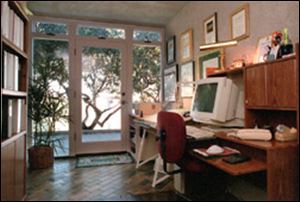
Making room in your home office is essential
2/21/2002
With more than half of the country-s work force telecommuting, home offices are no longer a luxury, but a necessity.
In 20 years, home offices will be as standard as bedrooms and bathrooms and more common than living rooms, according to a recent survey. In fact, a Kiplinger Newsletter report predicts that by 2025 all upscale new homes and most mid-priced ones will be routinely designed with one, if not two, fully equipped offices.
Builder Tim Earnest of Claystone Custom Homes in Swanton sees it happening today.
"Pretty much every house that we do in the upper price range takes a home office," he says. "What we-re doing now is network cabling - running fiber optics - throughout the whole house.
"At $250,000 and below, it-s a specialty item. They-ll do a finished basement with their home office down there."
Many work-at-home couples are coping by carving residential offices out of existing space. Some can afford individual offices, but many have to share a room. One of their challenges is designing a work area that serves the needs of both partners, often employed in distinctly different professions.
"In the higher-end homes, you pretty much have the den already there as an office," Mr. Earnest says. His company uses the den already in the home plans and upgrades it with fiber optic cable. He says the price of the home usually goes up only about $2,200.
As for his own home office, Mr. Earnest says, "I love it. The whole house is wired for networking cable. So if the kids are upstairs and I-m downstairs, we could all be on the Internet at the same time. It works out nice."
If you-re thinking of converting part of your living space to a home office, first ask yourself some questions, says interior designer Stephanie Mathews, a member of the American Society of Interior Designers.
Will the office be used to operate a business? Will it be a space for handling home finances or doing online shopping? Will it have to accommodate work that requires special equipment? Does it need space for meetings with customers or colleagues?
"Your needs and goals determine the home-office layout that will work best for you. You must have a plan," advises Mathews, who works out of a home office she designed for herself. "The important thing to remember is that it has to be functional and well organized so you can get things done.
"The purpose of having a home office is to help you be more productive and effective, so it needs to be well lighted, well organized and pleasant to work in."
With your needs clearly in mind, office design experts like Phil Jennings of Next Design Team suggest creating a list of components. Among the basics are a desk/shelving system that will house a computer, monitor, printer, fax and telephone, plus filing and storage space for books, stationery supplies, documents and special tools.
Optimal space use generally is achieved with custom cabinetry, according to Mathews, but freestanding office furniture brings the advantage of flexibility, plus it-s less expensive. But, Mathews points out, costs of a well-designed home office most likely can be recouped in added home resale value since home offices are in such demand.